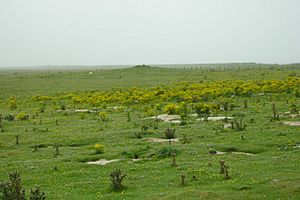Tofts Ness facts for kids

Cairns on Tofts Ness peninsula, Sanday
|
|
| Location | Sanday, Orkney |
|---|---|
| Type | Prehistoric settlement |
| History | |
| Periods | Neolithic, Bronze Age, Iron Age |
| Reference no. | SM5080 |
Tofts Ness is a special place on the north-east tip of Sanday Island in Scotland. It's a very old site where people lived long, long ago, starting in the Stone Age and continuing through the Bronze and Iron Ages. This area is like an open-air museum, with ancient mounds, stone piles called cairns, and old buildings hidden under the ground. Tofts Ness is also known for several shipwrecks that happened near its shores.
Contents
Discovering Tofts Ness
Tofts Ness is a small piece of land sticking out into the sea on the island of Sanday. This ancient site is huge, filled with old earth banks, cairns, and remains of buildings. There are more than 300 mounds and cairns here. Many of these mounds were likely used as burial places for people from long ago. One of the biggest mounds might even be the remains of a broch, which was a type of round stone tower built in ancient Scotland.
Scientists have studied Tofts Ness since the 1980s. They dug up parts of the land and used special equipment to see what was underground. They found that Tofts Ness was once a busy settlement, maybe a farm or a place where people processed seaweed. People lived here during two main periods. The first was from the Stone Age to the early Bronze Age. The second was from the late Bronze Age to the early Iron Age. During their digs, archaeologists found a round house and another building connected to it. The soil around these buildings showed signs that people used to grow crops there.
Close to the sea, two stone buildings without roofs and two fenced areas have been found. You can even see them in pictures taken from above! These old structures are lined up with the shoreline. Tofts Ness was officially protected as an important historical site in 1991. The protected area has since been made bigger to include even more ancient remains.
Life and Times at Tofts Ness
Ancient Farmers and Their Lives
During the late Stone Age and early Bronze Age, the people living at Tofts Ness were very clever farmers. They worked hard to clear the land, moving stones to create fields. They also knew how to make the sandy soil better for growing food. They mixed animal waste with ash and spread it on their fields. This helped their crops grow strong!
The people of Tofts Ness grew barley, which is a type of grain. They also raised animals like sheep, cattle, and pigs. To make sure they had enough to eat, they also caught fish, collected shellfish, hunted seabirds, and gathered wild plants. People continued to live and farm at Tofts Ness until the early Iron Age.
Shipwrecks Near Tofts Ness
The waters around Tofts Ness have been dangerous for ships over the centuries. Many ships have been wrecked here, telling stories of storms and difficult journeys.
- The Taindale was a ship carrying flax and wood. It got stuck on Tofts Ness on November 19, 1778. We don't know if it was ever pulled free.
- The Ann & Christian crashed near Tofts Ness on February 17, 1771. It was carrying coal.
- The Rinaldo was a big ship, 400 tons, full of flax, hemp, and linseed. It got stuck on Tofts Ness on January 14, 1810. It's also unknown if this ship was saved.
- The Friende Veni was a type of small ship called a galiot. It was carrying wood and crashed on Tofts Ness on April 18, 1811.
- The Express was a schooner, a ship with two masts. It was sailing from Lerwick to Belfast when it wrecked on Tofts Ness on February 25, 1835. Luckily, the crew and some of the cargo were saved.
- The Gunhild was a large wooden ship from Norway. It crashed on the south end of Tofts Ness on April 15, 1888. It had a crew of sixteen people and was carrying timber.
- The Frederic Eugene was another wooden ship that wrecked on June 24, 1891. It was carrying battens (strips of wood) and iron tubes. This ship had sailed all the way from Hernosand, Sweden, and was headed for Brazil.
See also
- Prehistoric Orkney
- Timeline of prehistoric Scotland
- Scheduled monuments in Orkney

